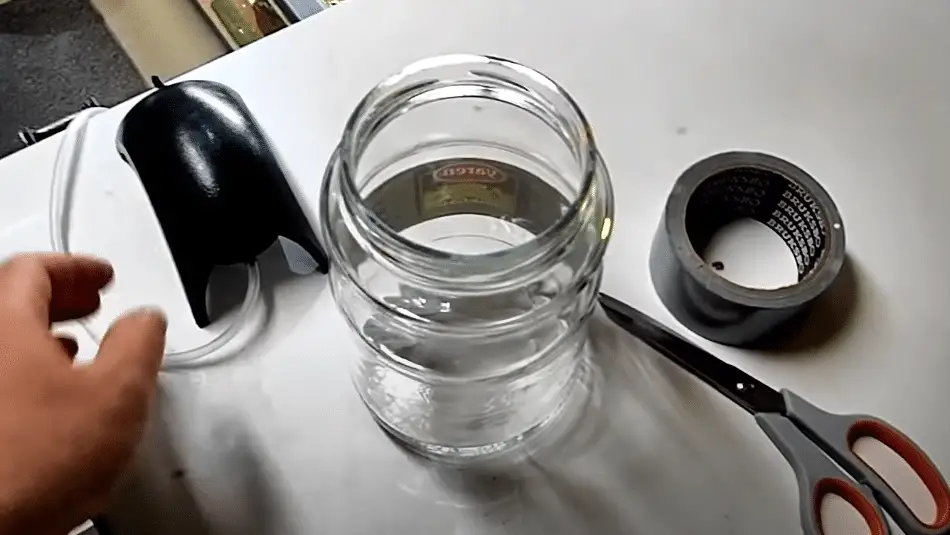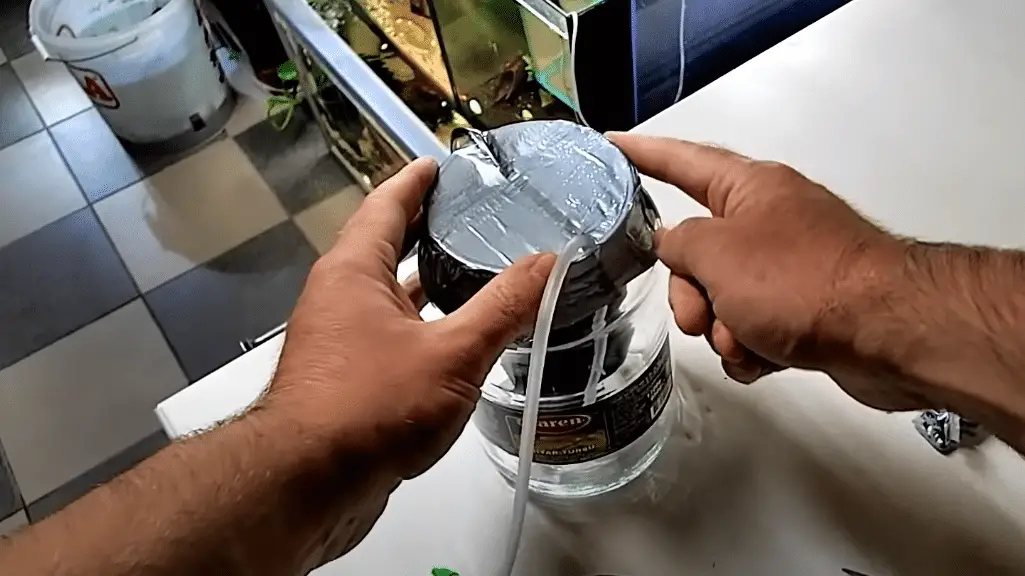Hello, fellow aquarium enthusiasts! I’m Mark , an aquarium hobbyist with over four decades of experience. Today, I’m going to share a simple, cost-effective, and safe DIY method I’ve developed to silence the persistent hum of an aquarium air pump. This method has been a game-changer for me, and I’ve been using it for the past twenty years. Let’s dive in!
, an aquarium hobbyist with over four decades of experience. Today, I’m going to share a simple, cost-effective, and safe DIY method I’ve developed to silence the persistent hum of an aquarium air pump. This method has been a game-changer for me, and I’ve been using it for the past twenty years. Let’s dive in!
Materials You’ll Need
To quiet your aquarium air pump using this method, gather the following items:
- Aquarium air pump: The source of the noise you’re aiming to silence.
- Empty glass or plastic jar: A container large enough to house the air pump, allowing for proper air circulation.
- Duct tape: A strong adhesive tape to secure the jar lid and ensure proper sealing.
- Scissors or a sharp knife: To cut the duct tape as needed.
- Airline tubing: The tubing that connects your air pump to the air stone or other aquarium accessories.
- Optional: Rubber mat or foam padding: To further dampen vibrations and reduce noise.

Step-by-Step Guide
Here’s a detailed guide to silencing your aquarium air pump:
air pump:
- Clean the jar thoroughly to ensure no contaminants could harm your aquarium’s
 ecosystem.
ecosystem. - Place the air pump inside the jar, ensuring enough space around the pump for proper air circulation. If you have a rubber mat or foam padding, place it under the pump to further reduce vibrations and noise.
- Feed the airline tubing through the top of the jar, ensuring it’s connected to the air pump inside.
- Cut a strip of duct tape long enough to cover the jar’s opening. Place it halfway across the opening, leaving a small gap or hole for the airline tubing and proper air exchange. This breather hole is crucial for the air pump’s efficient functioning.
- Cut another strip of duct tape and place it on the opposite side of the first strip, covering the rest of the jar’s opening. Ensure the breather hole and space for the airline tubing are still present.
- Press the duct tape firmly against the jar’s opening, sealing the edges to minimize noise. Trim any excess tape with scissors or a sharp knife for a neat finish.
- Connect the other end of the airline tubing to your air stone or aquarium accessory as needed.
- Turn on your air pump to test its performance. You should notice a significant reduction in noise while still providing the necessary air supply to your aquarium.
- Adjust the breather hole size if needed, to balance noise reduction and air pump efficiency.
- Place the silenced air pump setup near your aquarium, ensuring all connections are secure, and enjoy a quieter fishkeeping experience.
Common Mistakes to Avoid
While this DIY method is simple and straightforward, there are a few common mistakes that can hinder its effectiveness. Avoiding these pitfalls will ensure your air pump operates efficiently and quietly:
- Not Securing the Pump Properly: One of the most common mistakes is not securing the air pump properly inside the jar. If the pump is not well-secured, it can fall down inside the jar, bending the air pipe and stopping the airflow. To avoid this, ensure that the pump is firmly placed inside the jar and the duct tape is securely fastened.
- Not Adding a Breather Hole: Another common mistake is not adding a breather hole to the jar. The breather hole is crucial for maintaining proper air exchange and preventing overheating. The hole only needs to be the diameter of a pencil to work effectively. Without this hole, the pump can be starved of air, reducing its efficiency and potentially causing it to overheat.
- Incorrect Placement of the Pump: The air pump should always be placed above the water level or have a check valve in place to prevent water from returning to the pump. Incorrect placement can lead to water damage and reduce the lifespan of your pump.
By avoiding these common mistakes , you can ensure the longevity of your air pump and maintain a peaceful and serene atmosphere in your aquarium.
, you can ensure the longevity of your air pump and maintain a peaceful and serene atmosphere in your aquarium.

Why This Method is Safe
Silencing your aquarium air pump using duct tape and a jar is not only a practical solution for reducing noise and vibrations but also safe when done correctly. Ensuring the presence of a breather hole is crucial for maintaining proper air exchange and preventing overheating. As a fellow fish/shrimp keeper, I tested this method for overheating concerns over a week, and the temperature remained stable.
when done correctly. Ensuring the presence of a breather hole is crucial for maintaining proper air exchange and preventing overheating. As a fellow fish/shrimp keeper, I tested this method for overheating concerns over a week, and the temperature remained stable.
The Science Behind This Method
To appreciate why this method effectively reduces noise and vibrations from your aquarium air pump, it’s helpful to understand the mechanics behind it. Here’s a detailed explanation of why this DIY solution works:
- Sound dampening: The jar acts as a barrier that contains and dampens the noise produced by the air pump. Glass and plastic jars have sound-dampening properties that help reduce the noise transmitted through the air. Additionally, duct tape contributes to sound dampening due to its flexibility, which helps absorb and dissipate sound vibrations.
- Vibration reduction: Placing the air pump inside the jar helps isolate it from the surface it’s resting on. This reduces vibrations that can contribute to the overall noise level. Additionally, using a rubber mat or foam padding under the air pump inside the jar further absorbs vibrations, lowering the noise even more.
- Sealing gaps: Using duct tape to seal the jar’s opening (or the lid, if available) helps create an enclosed space that further contains the sound. By covering most of the jar’s opening while leaving a breather hole, you’re minimizing the escape of noise while still ensuring proper air exchange.
- Air circulation and breather hole: The breather hole is essential for preventing overheating and maintaining air pump efficiency. It allows a controlled amount of air to enter and exit the jar, providing enough circulation to keep the pump operating optimally without allowing too much sound to escape.
- Customization: This DIY method is adaptable and allows you to make adjustments to the breather hole size and jar placement to strike the right balance between noise reduction and pump efficiency. This flexibility helps you achieve the most effective noise reduction for your specific air pump and aquarium setup.
Additional Tips and Potential Issues
While the duct tape and jar method is an effective solution to silence your aquarium air pump, there are some additional tips and potential issues to consider:
- Rubber mat: Placing a piece of rubber mat under the jar can further reduce vibrations and noise. The rubber mat absorbs vibrations and prevents them from transferring to the surface the jar is resting on.
- Warranty concerns: Although you are not taking the air pump apart, be aware that using this method may void the warranty on your air pump. By placing the pump in a different condition than it was intended to be used, you may affect the manufacturer’s warranty coverage. Always consult your air pump’s warranty terms before proceeding.
- Overheating prevention: Ensure the breather hole is of adequate size to maintain proper air exchange and prevent overheating. Monitor the air pump’s temperature during initial use to ensure it remains stable.
- Regular maintenance: Check the air pump, jar, and duct tape periodically for any signs of wear or damage. Replace the duct tape or jar as needed to maintain the effectiveness of this noise reduction method.
Conclusion
With just a few household items – a jar, some duct tape, and patience- you can significantly reduce the noise and vibrations from your air pump. This DIY method is not only effective but also safe for both you and your aquatic friends. By following the steps outlined in this guide, you can create a more peaceful and serene atmosphere in your living spaces, enhancing the joy of your fishkeeping hobby.
So, go ahead and give this method a try. You’ll be surprised at the difference it can make. And remember, if you need any help or have any questions, please don’t hesitate to reach out. I’m here to help you make the most of your aquarium experience.
FAQ: Quieting Your Aquarium Air Pump
Q. How do I stop my aquarium air pump from making noise? A. You can reduce noise from your aquarium air pump by placing it inside a jar and sealing the jar with duct tape, leaving a small breather hole for air circulation.
Q. Why is my fish tank air pump making a loud sound? A. Your fish tank air pump might be making a loud sound due to vibrations, loose parts, or a damaged diaphragm. Placing it in a jar can help reduce these noises.
Q. Do air pumps annoy fish? A. Excessive noise or vibrations from an air pump can potentially stress fish. However, a properly functioning and quiet air pump is generally not a problem.
Q. Why is my Tetra air pump so loud? A. Your Tetra air pump might be loud due to wear and tear, a loose part, or a need for cleaning. Using the jar and duct tape method can help reduce the noise.
Q. How do you fix a noisy pump? A. You can fix a noisy pump by checking for loose parts, cleaning it, or using a noise reduction method like the jar and duct tape technique.
Q. Is it OK to turn off aquarium air pump at night? A. It’s generally not recommended to turn off your aquarium air pump at night as it can disrupt the oxygen supply for your fish.
Q. Why is my water pump too noisy? A. Your water pump might be noisy due to a malfunction, a need for cleaning, or vibrations. Placing it on a rubber mat can help reduce the noise.
Q. Is a loud pump bad for fish? A. A loud pump can potentially stress fish due to the noise and vibrations. It’s best to keep your pump as quiet as possible.
Q. Do fish get stressed by loud noises? A. Yes, fish can get stressed by loud noises. It’s important to maintain a quiet and peaceful environment for your fish.
